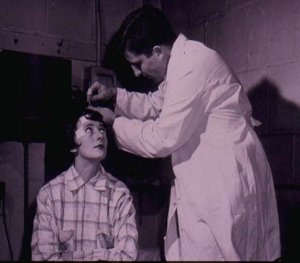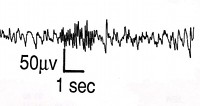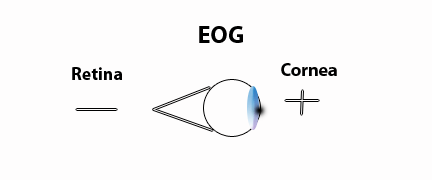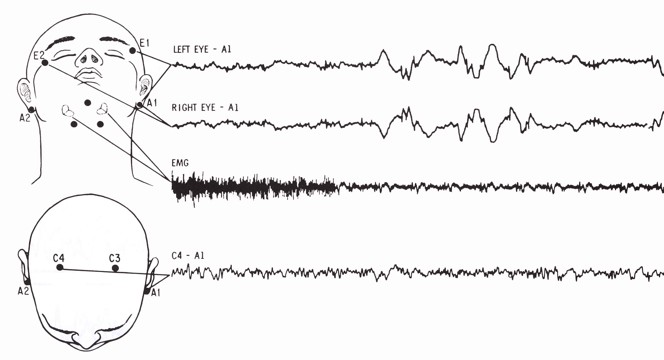
| Connect & Subscribe |
Polysomnography - How Sleep Is Measured
Written by Kevin Morton with adaptations from the Stanford Sleep Book
Before you launch into your journey to learn all about sleep, it is important to first understand the different measurements that are used to study and make distinctions in the land of slumber.
 Dr. Dement applies electrodes to his wife Pat to perform some of the earliest all-night, continuous EEG recordings.
Dr. Dement applies electrodes to his wife Pat to perform some of the earliest all-night, continuous EEG recordings.
The standard method used to study sleep is called polysomnography. It uses electrode patches placed on specific parts of the sleeper's head and body to record electrical activity on a polygraph (resulting in readable data that looks like scribbled lines).
There are a lot of places on the body that sleep researchers can measure activity from, but eye movements, muscle movements, and brain activity are especially important. These three target spots are known as the polysomnography core, and are often depicted one on top of the other when sleep data is presented.
Brain Activity - EEG
The electroencephalogram (or EEG) is a measurement of bioelectric brain activity (The Greek word enkephalos means "brain," so "electro-encephalo-graphy" signifies graphing the electrical activity of the brain). EEG measurements are generated through electrodes placed on the scalp and have proven a vital tool for studying sleep.
 For instance, the presence of a sleep spindle (depicted above) signifies that the sleeper is in non-REM sleep, stages 2-4.
For instance, the presence of a sleep spindle (depicted above) signifies that the sleeper is in non-REM sleep, stages 2-4.
When looking at EEG levels, sleep researchers can clearly see distinctions between the different stages of sleep, as well as when the initial sleep onset actually occurs. By looking at the shapes of the polygraph lines, they can better understand the sleeper's journey through sleep.
Eye Movements - EOG
Electro-oculography (or EOG), the standard method used to measure eye movements during sleep, is incredibly useful for studying rapid eye movement sleep (which you'll learn about in Sleep Step 2).
It's also really cool how EOG works. It was a breakthrough for sleep scientists when it was discovered that the front of the eye (the cornea) is electrically positive compared to the back (the retina). Therefore, when the eye moves left, right, up, or down the change in voltage can be picked up by electrodes placed on the sleeper's face and recorded on the polygraph.
Here's a picture of the electrical charges of the eye to give you a sense of how this works:

Muscle Activity - EMG
The third thing that is virtually always measured when studying sleep is muscle activity, by a method called the electromyogram (or EMG).
Muscles emit electrical potentials when they move, and that electricity is also detected by electrodes and recorded on the polygraph. EMG electrodes are usually placed over the sleeper's chin muscles.
The Polysomnography Core In Action
 This image shows the standard electrode placement sites used in polysomnography, in addition to some typical polygraph readings to the right. The numbers indicate locations that are part of the more complex, standardized system that is used around the world. In non-sleep clinical tests that attempt to detect abnormal brain waves, as many as 20 or more electrodes are used on the scalp. In routine sleep studies, however, only one EEG tracing is necessary.
This image shows the standard electrode placement sites used in polysomnography, in addition to some typical polygraph readings to the right. The numbers indicate locations that are part of the more complex, standardized system that is used around the world. In non-sleep clinical tests that attempt to detect abnormal brain waves, as many as 20 or more electrodes are used on the scalp. In routine sleep studies, however, only one EEG tracing is necessary.
Although it is possible to measure a large variety of physiological processes during sleep, typically not more than three additional measurements are taken--breathing, heart rate, and the contraction of leg muscles.
These recordings serve crucial purposes in diagnosing and treating patients in sleep disorders centers, where the cumulative total of all the measurements are bunched together into the term clinical polysomnography.
And join the conversation with your own comments here:
blog comments powered by DisqusAbout This Site
Welcome! This site is continuously being created by students of Dr. William C. Dement's Sleep And Dreams course at Stanford University.
We made this site as a call to action for people all over the world to live healthier, happier, safer, and more productive lives by learning about their own sleep. We have faith that reading the information provided on this site will motivate you to be smart about your sleep deprivation and strategic about your alertness in order to live life to your fullest, most energetic potential.
In fact, we challenge you to do so! What do you say, are you up for the challenge?
Interviews With Sleep Specialists: Insights Into the Worlds of Sleep Medicine & Sleep Business
America's Most Dangerous Disorder: What Is Sleep Apnea Doing To Your Sleep?
Sleep Debt: How Much More Will You Achieve When You Reduce Yours?
The Stages Of Sleep: The Journey Through The Night
Delayed Sleep Phase: You Want To Sleep But You're Not Tired Yet
Paralyzed at Night: Is Sleep Paralysis Normal?
Sleep In Words: Smart, Strange, and Funny Quotes About Sleep
Sleep Disorders In Children: What's Keeping Your Child From A Full Night's Rest?
Attacks of Pavor Nocturnus (a.k.a. Sleep Terrors, Night Terrors, or Incubus Attacks)
The Stanford Sleep Book
Dr. Dement's pioneering textbook has been the core text for Sleep and Dreams since 1980, but it has just recently been made available to the wider public for the first time.
In it you'll find a more detailed account of the most important things you need to know about sleep, alertness, dreams, and sleep disorders. Studies, statistics, plus plenty of Dr. Dement's classic anecdotes painting the history of sleep medicine.
Preface | Intro | Contents | Get A Copy
More Sleep Resources
The Zeo
A revolution in personal sleep tracking, the Zeo is a wireless headband that transmits your brainwaves in realtime to a dock (pictured here) or your smartphone. The result? You can wake up and see exactly what stages of sleep you were in during the night! Unprecedented personalized sleep knowledge.
Sleep Paralysis: A Dreamer's Guide
Ever woken up paralyzed? A surprising number of us have, believe it or not. But few know the actual causes of this phenomenon, and fewer still how to exert control over it. Dream researcher and sleep paralysis expert Ryan Hurd shares breakthrough insights into how to do just that.
Important Disclaimer
Please Note:
The information found on this page and throughout this site is intended for general information purposes only. While it may prove useful and empowering, it is NOT intended as a substitute for the expertise and judgments of healthcare practitioners.
For more info, see our
Terms of Use.









